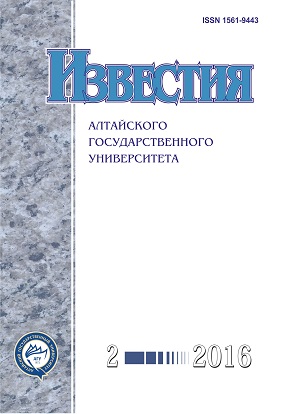To the Question about the Reasons for the Formation of the Omsk Eparchy
Abstract
This article is an attempt to analyze the reasons for the creation of the Eparchy (diocese) of Omsk in 1895, with the synodal decree being issued and signed. The stated problem is urgent, since in this period of time the annexation of the Southern Kazakhstan territory to the Russian Empire completed, and the administrative-territorial unit system of West Siberia was formed. Russian Orthodox Church, one of the main political institutions of the state, played an important role in the spiritual aspect of the control system in the region and the process of Russification there. Therefore, a new administrativeterritorial structure of the Russian Orthodox Church consistent with the provincial administrative and territorial structure was formed by the end of the 19th century in West Siberia. In this regard, the identification of the causes which led to a new church unity appearing on the map of West Siberia in the late 19th century is of great scientific interest. Based on the analysis of a wide range of documents and literature, the author identifies a number of reasons for this historic event. According to the researcher, the most significant was the process of making the Central Asian borders of the Russian Empire and the formation of the Governor-generalship of the Steppes. This new administrative-territorial unit demanded its inclusion in the scope of activities of the Russian Orthodox Church. Another important reason for the formation of the Eparchy of Omsk was peasant colonization of the Kazakh steppe, which began in the late 19th century. This led to a sharp increase in the number of the Orthodox population of the region. Among other causes are ethnic and religious heterogeneity of the steppe, and the need to spread the influence of the Russian Orthodox Church among the Old Believers, sectarian and Muslim population.
DOI 10.14258/izvasu(2016)2-25
Downloads
Metrics
References
Лысенко Ю.А., Анисимова И.В., Тарасова Е.В., Стурова М.В. Традиционное казахское общество в национальной политике Российской империи: концептуальные основы и механизмы реализации (XIX - начало ХХ в.) - Барнаул, 2014.
Лысенко Ю.А. Очерки истории Русской православной церкви в Казахстане (XVIII - начало XX в.). - Барнаул, 2011.
Алексеенко Н.В., Алексеенко В.Н. Славянское население Казахстана XVIII-XX вв. - Усть-Каменогорск, 2009.
Российский государственный исторический архив (РГИА). - Ф. 796. - Оп. 442. - Д. 1965.
Усов Ф. Статистическое описание Сибирского казачьего войска. - СПб., 1879.
Лысенко Ю.А. Структура, цели и задачи деятельности Киргизских православных миссий Оренбургской и Омской епархий (сравнительный анализ) // Изв. Алт. гос. ун-та. - 2009. - № 4 (64).
Izvestiya of Altai State University is a golden publisher, as we allow self-archiving, but most importantly we are fully transparent about your rights.
Authors may present and discuss their findings ahead of publication: at biological or scientific conferences, on preprint servers, in public databases, and in blogs, wikis, tweets, and other informal communication channels.
Izvestiya of Altai State University allows authors to deposit manuscripts (currently under review or those for intended submission to Izvestiya of Altai State University) in non-commercial, pre-print servers such as ArXiv.
Authors who publish with this journal agree to the following terms:
- Authors retain copyright and grant the journal right of first publication with the work simultaneously licensed under a Creative Commons Attribution License (CC BY 4.0) that allows others to share the work with an acknowledgement of the work's authorship and initial publication in this journal.
- Authors are able to enter into separate, additional contractual arrangements for the non-exclusive distribution of the journal's published version of the work (e.g., post it to an institutional repository or publish it in a book), with an acknowledgement of its initial publication in this journal.
- Authors are permitted and encouraged to post their work online (e.g., in institutional repositories or on their website) prior to and during the submission process, as it can lead to productive exchanges, as well as earlier and greater citation of published work (See The Effect of Open Access).








